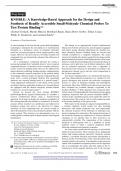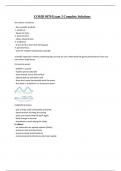Angewandte
Chemie
DOI: 10.1002/anie.200703323
Drug Design
KNOBLE: A Knowledge-Based Approach for the Design and
Synthesis of Readily Accessible Small-Molecule Chemical Probes To
Test Protein Binding**
Christof Gerlach, Martin M�nzel, Bernhard Baum, Hans-Dieter Gerber, Tobias Craan,
Wibke E. Diederich, and Gerhard Klebe*
In memory of J%rg St�rzebecher
At the beginning of the last decade, potent high-throughput The design of an appropriately focused combinatorial
technologies stimulated the development of combinatorial library starts with the selection of a central fragment equipped
chemistry as a productive source of candidate molecules with linker groups allowing substitutions by standard syn-
suited for screening biological activity against putative drug thetic chemistry. Putative building blocks are selected and
targets. However, the sheer increase of readily available test virtually assembled in a computer simulation. The actual
compounds has not dramatically enhanced the efficiency of retrieval of suitable side chains is guided by the shape and the
lead discovery.[1–3] physicochemical properties of the binding pocket of the target
As a consequence, compound selection for testing is protein. Usually protein binding pockets, particularly those in
moving increasingly from “optimally diverse” sets to targeted proteases, can be split into a set of distinct subpockets, which
compound libraries. As proteins occur in families character- can be examined separately. Once such a subpocket is
ized by conserved binding motifs, they can be addressed by characterized and extracted, its description according to the
ligand skeletons exhibiting binding epitopes complementary pseudocenter concept can be used for cavity comparisons in
to the commonly exposed properties of the protein family. the Cavbase approach.[10–13]
Accordingly, efficient design of targeted compound libraries In Cavbase, binding pockets are automatically detected,
starts with a central privileged skeleton that specifically and their physicochemical properties are encoded by five
addresses the exposed binding motif of a protein family.[4] generic descriptors that describe the molecular recognition
Using appropriate substituents or side chains of the central features in terms of hydrogen bonding and hydrophobic
privileged skeleton, individual members of a focused library interactions. More than 130 000 cavities have been stored, and
are equipped with the desired selectivity towards distinct their occupants are available through a hyperlink to the
members of a protein target family.[5–8] database Relibase.[14] Both databases store structural infor-
Herein, we present the novel strategy KNOBLE mation about crystallographically determined protein–ligand
(KNOwledge-Based Ligand Enumeration) to assemble a complexes deposited with the protein databank (PDB).[15]
focused combinatorial library using a structure-based Cavbase maps a predefined query cavity against the entire set
approach. In all steps of design, the synthetic accessibility of of stored entries. The result is a list of cavities ranked in order
the starting materials and products is considered. To test the of decreasing similarity to the query cavity.
concept, library members are synthesized and subjected to With respect to the design of a targeted compound library,
biological testing. Our goal is the discovery by simple a Cavbase similarity search returns not only matching
chemistry of lead compounds that are potent enough to subcavities with similar properties but, most importantly,
allow determination of the crystal structure together with the the chemical structures of the molecules or molecular frag-
target protein. This structure can subsequently serve as a ments occupying these subcavities. The chemical structures of
starting point to embark upon in-depth structure-based ligand the retrieved occupants are subjected to a search in chemical
optimization. catalogues to see whether they or their derivatives are
commercially available. The composition of the returned
[*] Dr. C. Gerlach, M. M�nzel, B. Baum, H.-D. Gerber, T. Craan, chemicals is subsequently used as a guideline to design
Dr. W. E. Diederich, Prof. Dr. G. Klebe synthetic routes to build a targeted compound library
Institut f�r Pharmazeutische Chemie following combinatorial chemistry principles.
Philipps-Universit0t Marburg As a case study to probe this new strategy, we selected the
Marbacher Weg 6, 35032 Marburg (Germany) family of serine proteases. These enzymes cleave polypeptide
Fax: (+ 49) 6421-282-8994
chains with varying sequence selectivity. Along the reaction
E-mail: klebe@mailer.uni-marburg.de
pathway, a covalently attached acyl-enzyme intermediate is
[**] The DFG-Graduiertenkolleg “Proteinfunktion auf atomarer Ebene”
(C.G.) and the DPhG “Stiftung zur FArderung des wissenschaftli- formed, and the N-terminal part of the cleaved peptide chain
chen Nachwuchses” (W.E.D.) are gratefully acknowledged for their remains bound to the protein. Consequently, serine proteases
financial support. exhibit well-established recognition pockets on the unprimed
Supporting information for this article is available on the WWW side to accommodate the amino acid side chains of the N-
under http://www.angewandte.org or from the author. terminal part of the peptidic substrate next to the cleavage
Angew. Chem. Int. Ed. 2007, 46, 9105 –9109 � 2007 Wiley-VCH Verlag GmbH & Co. KGaA, Weinheim 9105
&&&&&&&&&&&&&&&&&&&&&&&&&&&&&&&&&&&&&&&&&&&&&&&&&&&&&&&&&&&&&&&&&&&&&&&&&&&&&&&&&&&&&&&&&&&&&&&&&&&&&&&&&&&&&&&&&&&&&&&&&&&&&&&&&&&&&&&&&&&&&&&&&&&&&&&&&&&&
&&&&&&&&&&&&&&&&&&&&&&&&&&&&&&&&&&&&
Take advantage of blue reference links &&&&&&&&&&&&&&&&&&&&&&&&&&&&&&&&&&&&
&&&&&&&&&&&&&&&&&&&&&&&&&&&&&&&&&&&&&&&&&&&&&&&&&&&&&&&&&&&&&&&&&&&&&&&&&&&&&&&&&&&&&&&&&&&&&&&&&&&&&&&&&&&&&&&&&&&&&&&&&&&&&&&&&&&&&&&&&&&&&&&&&&&&&&&&&&&&
, Communications
site. Furthermore, all serine proteases bind their substrates on subpockets and ligand occupants across a protein family is
the unprimed side through hydrogen bonds to the peptide easily possible.
backbone. Once a particular ligand fragment had been selected as a
We picked thrombin as a reference for this case study. This putative building block for the construction of a combinato-
enzyme exposes three well-defined binding subpockets to rial library, a search in the Sigma–Aldrich catalogue was
recognize the N-terminal substrate. Using these cavities as performed using the program JME.[16] For the different
queries for a Cavbase search revealed about 4000 hits in each subpockets, these searches retrieved possible reaction com-
case. For the S1 subpocket, 646 cavities from other serine ponents, which are given in the Supporting Information. The
proteases were matched; for the S3 pocket, 550 such cavities list of commercially available starting materials was then
were found. In case of the S2 pocket, only 274 entries from evaluated with respect to attached functional groups that are
other serine proteases were retrieved, thus indicating the suited to connect the individual building blocks by a generally
structural uniqueness of S2 in thrombin. This selectivity- applicable synthetic route. In the synthesis design, we decided
determining pocket is rather tight and spatially restricted by to focus on ester, amide, and sulfonamide bond formation as
the thrombin-specific 60 loop. well as on nucleophilic substitution reactions. Three frag-
Closer analysis of the matching S3 pockets highlights the ments, (S)-prolinol, (S)-2-(hydroxymethyl)piperidine, and
hydrophobic character of this site, which is strongly deter- (S)-valinol, were finally selected as central moieties to
mined by a highly conserved tryptophan residue forming the address the S2 pocket (Scheme 1).
floor of the pocket (e.g. acrosin, cathepsin G, factor VIIa, To further diversify the central P2 moiety, a glycine spacer
factor IXa, factor Xa, factor XIa, chymase, trypsin, C1s- was attached between P2 and P3. The functional groups of
elastase, tryptase, t-plasminogen activator, protein C, and this additional spacer are appropriate to address the non-
granzyme A). Similarly, the search retrieved S1 pockets from, specific backbone recognition site exposed by all serine
for example, cathepsin G, factor VIIa, factor IXa, factor XIa, proteases. We chose ester bond formation to connect the
trypsin, tryptase, protein C, factor Xa, t-plasminogen activa- central moiety with a group propitious to address the S1
tor, enteropeptidase, and urokinase. pocket. Finally, to place a suitable building block into S3, an
Subsequently, the actual occupants were extracted in amide bond was formed using either the amino functionality
terms of ligand fragments. As a first attempt, we decided to in the P2 central moiety or the glycine spacer. Alternatively,
design a compound library for thrombin. Thus, in each step, a bond formation through nucleophilic substitution was envis-
comparison with the thrombin reference subpocket was aged. In Scheme 1, carboxylic acid derivatives suited to
performed to retrieve only fragments that potentially exhibit address the S1 pocket are listed together with carboxylic and
a similar interaction pattern with the target protein. Evaluat- sulfonic acid derivatives as well as the chloro derivatives to
ing the occupants of the S2 pocket matches highlights the address the S3 pocket. The selected P1 to P3 building blocks
unique shape of this pocket in thrombin: among the 100 best- were assembled on the computer following Scheme 2 and
ranked solutions, 98 examples are found in other thrombin docked into the binding pocket of thrombin using the
structures. combinatorial module of FlexX.[17, 18] Two libraries, with and
Ligand fragments with an isopropyl group, a small without the glycine spacer, were assembled, each comprising
aliphatic or heteroaliphatic ring such as a pyrrolidine 507 possible members. For each docking run, the 10 best
moiety, or partially aromatic building blocks were preferen- solutions were stored and rescored using DrugScoreCSD.[19]
tially detected (Figure 1). Visual inspection of the docking solutions was performed
In thrombin and many other members of the trypsin-like using the graphical interface to evaluate the generated
serine proteases, the S1 subpocket is dominated by the docking modes in terms of per-atom scoring contributions.[20]
aspartate 189 residue, which is embedded in a highly con- For synthetic simplicity we decided to use the 3-chloro-
served hydrophobic environment. The comparison of binding benzyl and 4-cyanophenyl portion from the list of best-scored
pockets reveals ligand building blocks with comparable solutions to address the S1 pocket (apart from ligands
pysicochemical properties, while the exact degree of similarity exhibiting an amidino or guanidino portion at this site,
in the amino acid sequence of the surrounding protein is much which involve more synthesis steps). Selection of synthesis
less important. Nevertheless, besides the popular basic candidates for S2 and S3 was guided by synthetic feasibility
residues derived from benzamidine, guanidine, or amino- and reactivity differences of the starting materials. The finally
pyridine building blocks, halogen-substituted aromatic moi- selected 2-pyridylacetic acid, p-fluorobenzoic acid, and the
eties were also suggested; these interact with a conserved tert-butyloxy carbonyl moiety for S3 showed up in several of
tyrosine residue at the floor of the S1 pocket (Figure 1). The the best-scored hits. From the list of best-scored derivatives,
most pronounced chemical diversity of occupants is proposed compounds 2–6 were selected, synthesized (Scheme 3), and
by the Cavbase search for the S3 pocket. For this pocket, subjected to a photometric enzyme kinetics assay.[21] They
possible side chains originate from other members of the showed inhibition in the micromolar range (see Scheme 3 and
serine protease family (Figure 1). the Supporting Information). Subsequently, we succeeded in
Thus, we see the strength of this approach, as not only diffusing 5 into crystals of thrombin, from which the complex
well-known thrombin inhibitors are used to create the structure could be determined (Figure 2). This structure can
combinatorial library. Cavbase provides easy access to an serve as a starting point to embark upon structure-based lead
entire class of proteins, and simple “hopping” between optimization.
9106 www.angewandte.org � 2007 Wiley-VCH Verlag GmbH & Co. KGaA, Weinheim Angew. Chem. Int. Ed. 2007, 46, 9105 –9109
&&&&&&&&&&&&&&&&&&&&&&&&&&&&&&&&&&&&&&&&&&&&&&&&&&&&&&&&&&&&&&&&&&&&&&&&&&&&&&&&&&&&&&&&&&&&&&&&&&&&&&&&&&&&&&&&&&&&&&&&&&&&&&&&&&&&&&&&&&&&&&&&&&&&&&&&&&&&
&&&&&&&&&&&&&&&&&&&&&&&&&&&&&&&&&&&&
Take advantage of blue reference links &&&&&&&&&&&&&&&&&&&&&&&&&&&&&&&&&&&&
&&&&&&&&&&&&&&&&&&&&&&&&&&&&&&&&&&&&&&&&&&&&&&&&&&&&&&&&&&&&&&&&&&&&&&&&&&&&&&&&&&&&&&&&&&&&&&&&&&&&&&&&&&&&&&&&&&&&&&&&&&&&&&&&&&&&&&&&&&&&&&&&&&&&&&&&&&&&





